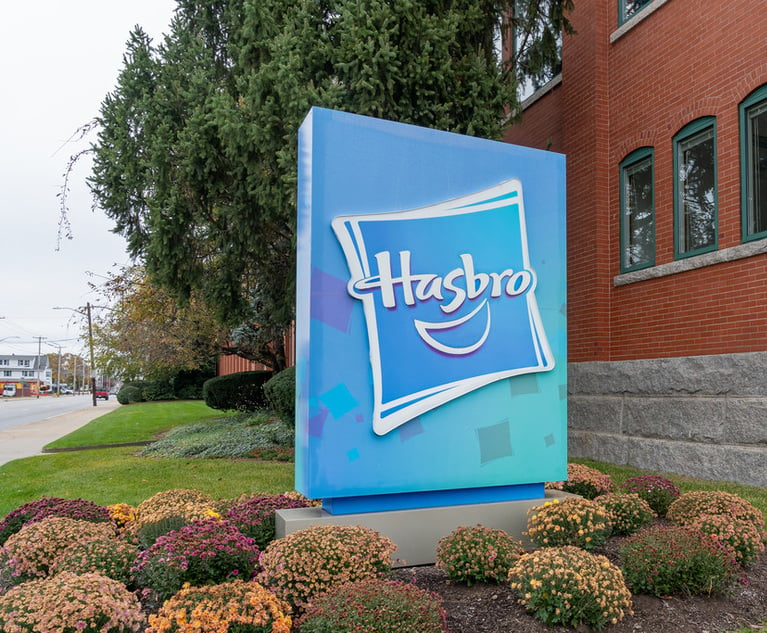IP: Light at the end of the tunnel
Four years ago, I spoke at a national advertising law conference on the sharp rise in consumer class action false advertising lawsuits. These lawsuits, once principally confined to California and a few other states, had by 2007 become the next big thing among the plaintiffs class action bar.
December 20, 2011 at 05:00 AM
5 minute read
The original version of this story was published on Law.com
Four years ago, I spoke at a national advertising law conference on the sharp rise in consumer class action false advertising lawsuits. These lawsuits, once principally confined to California and a few other states, had by 2007 become the “next big thing” among the plaintiffs' class action bar.
The potential for, and occasional reality of, large damages and attorneys' fees awards, plus heavy media coverage that presumed the advertiser was guilty as charged, made these suits attractive to the plaintiffs' bar and dangerous to advertisers throughout the U.S. These class actions are much more dangerous, in fact, than competitor versus competitor false advertising litigations filed under the federal statute known as the Lanham Act.
Although the recovery of damages and attorneys' fees to a prevailing plaintiff are available under the Lanham Act, they are relatively rare, and the substantial expense of discovery and concern about the potential “glass houses effect” of a Lanham Act suit have caused many prospective corporate plaintiffs instead to proceed before the National Advertising Division (NAD), the advertising industry self-regulatory body, where no damages or attorneys' fee awards are available.
By 2007, consumer class action false advertising suits had become a major cost item in corporate legal budgets, a distraction for in-house counsel and senior corporate management, as well as an unwanted source of bad publicity. When the U.S. economy nosedived a year later, and many U.S. companies faced hard times and even extinction, the risk posed by these class actions became even greater.
In the intervening four years, the legal landscape has changed significantly, and for corporations that advertise in the U.S., there is now a light at the end of the false advertising class action tunnel. Although many new false advertising class actions continue to be filed, U.S. courts have become increasingly amenable to granting early stage motions to dismiss, which end these suits in their infancy and greatly lower corporate legal fees, risk and the blood pressure of inside counsel.
Below are three important factors that have helped turn the litigation tide.
- Courts, legislatures and, in California, citizens through ballot box propositions, have largely rejected the notion that consumers should be permitted to act as “private attorneys general” and file false advertising lawsuits to remedy alleged injury to the public, even if those consumers suffered no injury from and did not base their own purchasing decisions on the challenged statements.
Today, courts regularly dismiss class actions for failure to state a claim for relief when plaintiffs fail clearly to allege that they personally have suffered a specific injury or loss directly resulting from the allegedly false advertising, or that they relied on the alleged falsity in making their purchase decisions. See, for example, Lieberson v. Johnson & Johnson Consumer Companies, 2011 WL 4414214 (D.N.J. 2011); Gifford v. U.S. Green Bldg. Council, 2011 WL 4343815 (S.D.N.Y. 2011).
- The Supreme Court issued two landmark decisions re-interpreting Rule 8 (a) of the Federal Rules of Civil Procedure.
Bell Atlantic Corp. v. Twombly, 550 U.S. 544 (2007), and Ashcroft v. Iqbal, 129 S. Ct. 1937 (2009), tightened the standards for pleading complaints in federal courts, by requiring a plaintiff to allege non-conclusory facts sufficient to demonstrate a plausible basis to believe the defendant is liable for the misconduct alleged. No more can a plaintiff satisfy Rule 8 merely by conclusorily alleging a cause of action in the hope discovery will later fill in the blanks. Twombly and Iqbal govern all federal court pleadings, regardless whether the alleged wrongs arise under federal or state law, and numerous recent false advertising class actions have been dismissed for failure to satisfy Rule 8(a). E.g Guzman v. Bridgepoint Education, Inc., 2011 WL 4964970 (S.D.Cal. 2011); Carrea v. Dreyer's Grand Ice Cream, 2011 WL 159380 (N.D. Cal 2011).
- Finally, numerous recent false advertising class actions have been premised on alleged violations of state law, without regard to the fact that defendant's alleged “misconduct” was either compelled by federal law or concerned acts regulated by a federal agency that was in the process of evaluating the alleged misconduct.
In such cases, early stage dismissal of the class action under the related doctrines of federal preemption and primary jurisdiction has been granted in numerous recent decisions. E.g., Chacanaca v. Quaker Oats Co., 752 F.Supp.2d 1111 (N.D. Cal. 2010); Gordon v. Church & Dwight Co., 2010 WL 1341184 (N.D.Cal. 2010).
Although false advertising class actions are not extinct, a shift in judicial assessments combined with legislative and electoral changes, has resulted in a major uptick in early stage dismissals. This trend gives hope that false advertising consumer class action suits will wane as the plaintiff's bar searches for greener pastures.
This content has been archived. It is available through our partners, LexisNexis® and Bloomberg Law.
To view this content, please continue to their sites.
Not a Lexis Subscriber?
Subscribe Now
Not a Bloomberg Law Subscriber?
Subscribe Now
NOT FOR REPRINT
© 2025 ALM Global, LLC, All Rights Reserved. Request academic re-use from www.copyright.com. All other uses, submit a request to [email protected]. For more information visit Asset & Logo Licensing.
You Might Like
View All



Inside Track: Cooley's Modest Proposal to Make Executives Safer
Trending Stories
Who Got The Work
J. Brugh Lower of Gibbons has entered an appearance for industrial equipment supplier Devco Corporation in a pending trademark infringement lawsuit. The suit, accusing the defendant of selling knock-off Graco products, was filed Dec. 18 in New Jersey District Court by Rivkin Radler on behalf of Graco Inc. and Graco Minnesota. The case, assigned to U.S. District Judge Zahid N. Quraishi, is 3:24-cv-11294, Graco Inc. et al v. Devco Corporation.
Who Got The Work
Rebecca Maller-Stein and Kent A. Yalowitz of Arnold & Porter Kaye Scholer have entered their appearances for Hanaco Venture Capital and its executives, Lior Prosor and David Frankel, in a pending securities lawsuit. The action, filed on Dec. 24 in New York Southern District Court by Zell, Aron & Co. on behalf of Goldeneye Advisors, accuses the defendants of negligently and fraudulently managing the plaintiff's $1 million investment. The case, assigned to U.S. District Judge Vernon S. Broderick, is 1:24-cv-09918, Goldeneye Advisors, LLC v. Hanaco Venture Capital, Ltd. et al.
Who Got The Work
Attorneys from A&O Shearman has stepped in as defense counsel for Toronto-Dominion Bank and other defendants in a pending securities class action. The suit, filed Dec. 11 in New York Southern District Court by Bleichmar Fonti & Auld, accuses the defendants of concealing the bank's 'pervasive' deficiencies in regards to its compliance with the Bank Secrecy Act and the quality of its anti-money laundering controls. The case, assigned to U.S. District Judge Arun Subramanian, is 1:24-cv-09445, Gonzalez v. The Toronto-Dominion Bank et al.
Who Got The Work
Crown Castle International, a Pennsylvania company providing shared communications infrastructure, has turned to Luke D. Wolf of Gordon Rees Scully Mansukhani to fend off a pending breach-of-contract lawsuit. The court action, filed Nov. 25 in Michigan Eastern District Court by Hooper Hathaway PC on behalf of The Town Residences LLC, accuses Crown Castle of failing to transfer approximately $30,000 in utility payments from T-Mobile in breach of a roof-top lease and assignment agreement. The case, assigned to U.S. District Judge Susan K. Declercq, is 2:24-cv-13131, The Town Residences LLC v. T-Mobile US, Inc. et al.
Who Got The Work
Wilfred P. Coronato and Daniel M. Schwartz of McCarter & English have stepped in as defense counsel to Electrolux Home Products Inc. in a pending product liability lawsuit. The court action, filed Nov. 26 in New York Eastern District Court by Poulos Lopiccolo PC and Nagel Rice LLP on behalf of David Stern, alleges that the defendant's refrigerators’ drawers and shelving repeatedly break and fall apart within months after purchase. The case, assigned to U.S. District Judge Joan M. Azrack, is 2:24-cv-08204, Stern v. Electrolux Home Products, Inc.
Featured Firms
Law Offices of Gary Martin Hays & Associates, P.C.
(470) 294-1674
Law Offices of Mark E. Salomone
(857) 444-6468
Smith & Hassler
(713) 739-1250






